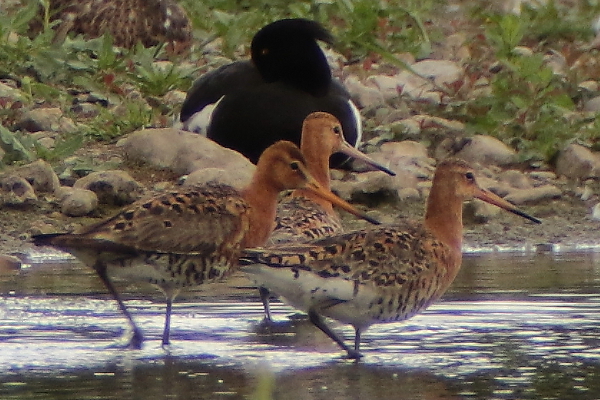
From Iceland to Israel - our birds go a long way!
One of the best things about ringing, besides the privilege of examining always fascinating and often really lovely birds in the hand, is getting information about their movements. It is after all the main reason for all the hard effort involved in catching and ringing them. The proportion of birds we hear about again is very small – for most small birds, typically around 1%, and for some, less than a quarter of that – but often the results are really interesting. Here are some of the more informative movements to and from Rye Meads reported in the past year.
Pride of place has to go to the Icelandic Black-tailed Godwit that was part of a flock of seven that dropped in one day in June. Thanks to its colour rings, we were able to ascertain that it had been ringed as an adult five years earlier, our first ever bird moving to or from Iceland. See our blog here for more details.
Colour rings are a useful way to observe ringed birds without needing to catch them to read a metal ring number. Thus we were also able to identify that a Black-headed Gull seen at Rye Meads in August had been ringed in Croatia as an adult some six months earlier. We have also been able to confirm through colour ring sightings that we’ve had at Rye Meads four Black-headed Gulls ringed as chicks at 70 Acres Lake, Fishers Green, one from the colony at Hosehill Lake in Berkshire, and an adult ringed at the Pitsea Landfill site on the Thames Estuary.
We have also seen a couple of colour-ringed Little Egrets, both ringed as chicks at the heronry just down the valley at Netherhall in 2013. Clearly these have not dispersed far from their place of birth!
Whilst we are on the Heron family, it was gratifying that the rehab Bittern that was ringed and released at Rye Meads in September 2016 (see here) was back at Rye Meads and apparently thriving in February 2017, when Jay Ward took some remarkable photos enabling her ring number to be read.
Our wildfowl continue to die from the guns of hunters. Two of the more interesting were a Teal ringed as an adult male in December 2016 and shot in France in October 2017. We can wonder if it had been in north-eastern Europe or northern Asia to breed, as so many of our wintering Teal do, and was back in western Europe for the winter. For more information on our Teal movements, see our blog here. The other was a Pochard, ringed here as a duckling in 2015, and shot further south in France in the Gironde region in September 2017.
No distant recoveries, but a couple of interesting retraps of our resident rails. One of our Coots which was ringed as a juvenile in August 2008, and retrapped the following month, was not caught again until August 2017. So it was only 9 years old (the BTO’s current longevity record for Coot is 15 years, 3 months and 13 days) but interesting to think it’s not been retrapped in the intervening years. It’s obviously one of the brighter ones! The other was a Moorhen ringed as an adult in September 2008, and retrapped for the first time in the same place by the same ringer in April 2017. Another bird that is either smart, or has been elsewhere; now well over ten years old and perhaps homing in on the Moorhen longevity record of 11 years 3 months and 21 days, set in 1963!
For the fourth year in a row, we’ve had sufficient numbers of hirundines roosting in our reedbeds on Autumn passage to make targeted netting worthwhile, and these continue to deliver interesting movements. This year we’ve heard that our Sand Martins have been caught in Northumberland and Nottinghamshire, and we caught a bird ringed in Durham just twelve days before.
Some of our recoveries are a little bit strange: one of our Meadow Pipits was found freshly dead in the grille of a motorhome touring North Yorkshire!
We get all too few Bearded Tits here these days, so it was nice to catch a bird in February 2017 that had been ringed as an adult male the previous May at Wicken Fen in Cambridgeshire (so presumably breeding there). Bearded Tits are known often to roam in winter.
The family of birds we ring most of at Rye Meads are the warblers, so it’s no surprise that we have had plenty of interesting movements of these little migrants. Firstly, Chiffchaff: we had two birds which had gone to Spain, one to Belgium, and we controlled a Belgian bird moving in the other direction.
Sedge Warblers included a juvenile to Loire-Atlantique in France; an interesting bird ringed as a juvenile in 2013 and trapped near Antwerp in Belgium in July 2016 – not only a venerable four years old, but at a time of year suggesting it was breeding there; and a bird ringed in Finisterre, France in August 2015, and trapped at Rye Meads in April and July 2016 and in April and May 2017, so obviously breeding here.
We had two Reed Warblers go to the same location in the Sevilla region of Spain: one a juvenile ringed at the end of August 2016 and caught there almost exactly a year later, and the other ringed as a nestling in June 2015 and caught there the following April. Also interesting but less far-flung were two juvenile Reed Warblers ringed within a day of each other in August 2017, one was then caught 14 days later in Norfolk, the other 15 days later in East Sussex, classic cases of “juvenile dispersal”, which is where young birds leave their natal area to explore other areas, which has the benefits of locating new potential breeding locations, avoiding competition with siblings, and avoiding breeding with closely related individuals which could lead to inbreeding.
Finally, pride of place of warbler movements notified this past year goes to a Lesser Whitethroat, a bird we ring relatively few of and get even fewer recoveries. So we were particularly delighted when a juvenile ringed in September 2015, and so presumably on passage, was controlled by a ringer in March 2017 in the Mediin Hills in Israel. (See here for more details). Lesser Whitethroats are known to winter in an area from Egypt south to the Sudan, and to migrate through south-eastern Europe and around the eastern end of the Mediterranean, so this bird fits that pattern nicely. It is our first recovery of a Lesser Whitethroat from Israel.
Full details of all recoveries and controls are listed in our regular Bulletins, free every two months to Friends. If you’d like to become a Friend, take a look here.
